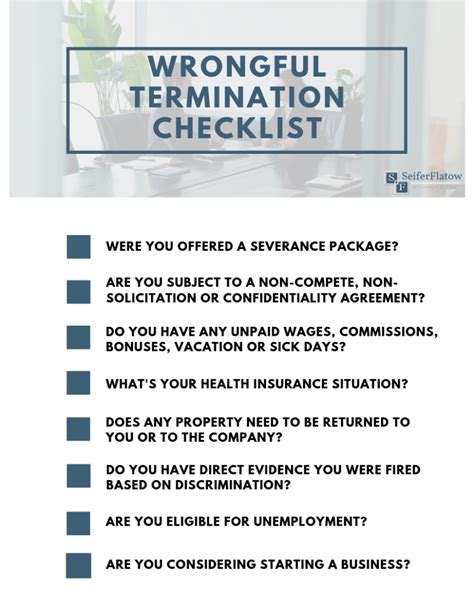Understanding Wrongful Termination: Examples & Checklist

Wrongful termination refers to the unlawful dismissal of an employee by their employer. It occurs when an employee is fired for reasons that are illegal or violate their employment rights. Wrongful termination can have severe consequences for both the employee and the employer, including legal repercussions and damage to the employer’s reputation.
Examples of Wrongful Termination
There are various scenarios in which wrongful termination can occur. Some common examples include:
-
Discrimination
Terminating an employee based on their race, gender, age, religion, disability, or any other protected characteristic is considered discriminatory and is illegal. For example, firing an employee because of their religious beliefs would be a clear case of wrongful termination.
-
Retaliation
If an employee is fired in retaliation for exercising their legal rights, such as reporting harassment or filing a complaint against their employer, it is considered wrongful termination. For instance, terminating an employee after they report sexual harassment would be retaliatory and illegal.
-
Breach of Contract
If an employment contract specifies certain conditions or terms of employment, and the employer terminates the employee in violation of those terms, it can be considered wrongful termination. For example, firing an employee before the agreed-upon contract end date without valid cause would be a breach of contract.
-
Whistleblowing
Terminating an employee for reporting illegal activities or unethical behavior within the company is illegal. Whistleblowers are protected by law, and firing them in retaliation for their disclosures is a violation of their rights.
-
Violation of Public Policy
Wrongful termination can occur when an employee is fired for reasons that go against public policy. For example, if an employee is terminated for refusing to engage in illegal activities or for reporting safety violations, it would be considered wrongful termination.
Checklist for Identifying Wrongful Termination
If you suspect that you have been wrongfully terminated, you can use the following checklist to help determine if your termination was unlawful:
-
Review Your Employment Contract
Check if your termination violates any terms or conditions specified in your employment contract.
-
Gather Evidence
Collect any evidence that supports your claim, such as emails, performance evaluations, or witness testimonies.
-
Review Company Policies and Procedures
Check if your termination violates any company policies or procedures.
-
Consult an Employment Lawyer
Seek legal advice from an experienced employment lawyer who can assess your case and guide you through the legal process.
-
File a Complaint
If you believe you have been wrongfully terminated, you may need to file a complaint with the appropriate government agency, such as the Equal Employment Opportunity Commission (EEOC).
-
Consider Mediation or Lawsuit
Depending on the circumstances, you may consider mediation or filing a lawsuit to seek compensation for the wrongful termination.
-
Document Everything
Keep a record of all communication, incidents, and actions related to your termination to support your case.
-
Explore Other Employment Opportunities
While pursuing legal action, start looking for new job opportunities to mitigate the financial impact of the termination.
-
Maintain Professionalism
Throughout the process, maintain professionalism and avoid any actions that could jeopardize your case or reputation.
-
Seek Emotional Support
Dealing with wrongful termination can be emotionally challenging. Seek support from friends, family, or professionals to help you cope with the situation.
Conclusion
Wrongful termination is a serious issue that can have significant consequences for both employees and employers. It is important for employees to be aware of their rights and understand what constitutes wrongful termination. If you believe you have been wrongfully terminated, it is crucial to seek legal advice and take appropriate action to protect your rights.
Frequently Asked Questions
-
What should I do if I suspect I have been wrongfully terminated?
If you suspect you have been wrongfully terminated, it is important to gather evidence, review your employment contract and company policies, and consult with an employment lawyer to assess your case.
-
What are some examples of wrongful termination?
Examples of wrongful termination include discrimination based on protected characteristics, retaliation for exercising legal rights, breach of contract, whistleblowing, and termination in violation of public policy.
-
What can I do if I have been wrongfully terminated?
If you have been wrongfully terminated, you can file a complaint with the appropriate government agency, such as the EEOC, and consider mediation or filing a lawsuit to seek compensation.
-
How can I prove wrongful termination?
You can prove wrongful termination by gathering evidence, such as emails, performance evaluations, or witness testimonies, and consulting with an employment lawyer who can help assess your case.
-
What are the potential consequences of wrongful termination?
The potential consequences of wrongful termination include legal repercussions, damage to the employer’s reputation, financial compensation for the employee, and emotional distress for both parties involved.
